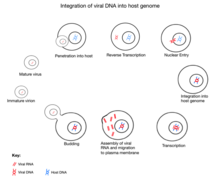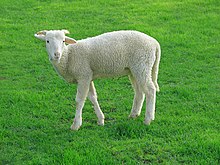User:S1801701/sandbox
Endogenous Jaagsiekte sheep retrovirus

During evolution, the sheep genome incorporated parts of the Jaagksiete sheep retrovirus, now known as endogenous Jaagsiekte sheep retrovirus (enJSRV).[1] There are 27 known copies of enJSRV in the sheep genome, of which five show intact sequences found in all retroviruses.[2][3] These seem to have been adopted by the sheep genome as enJSRV aids placental development and provides protection against similar retroviruses.[1][3] In vitro assays have found that enJSRV does this by blocking various stages of the viral replication cycle.[2] [3] [4] An example of this protection is seen in ovine endometrial epithelium where the high expression of enJSVR prevents exogenous JSVR from entering the cells via blocking the common receptor to both, HYAL2.[3] However, Jaagsiekte virus can sometimes mutate to overcome this protection, and there is evidence of this having occurred in the last 200 years.[1] There is also indication that the endogenization of Jaagsiekte virus is still occurring today.[2]
enJSRV mechanism in reproduction
[edit]
In sheep, enJSRVs are highly expressed in the epithelia lining different reproductive tissues, including the vagina, uterus and oviduct. The RNA of enJSRVs is first detected in the conceptus on day 12.[5] Experiments have found that the enJSRV envelope regulates trophoblast growth and differentiation within the peri-implantation conceptus.[6] It was discovered that enJSRVs are expressed in the trophectoderm cells of the placenta. Their expression coincides with the key events of conceptus elongation and onset of trophoblast giant binucleate cells (BNC) differentiation.[7] Furthermore, it was observed that an injection of morpholinos (an enJSRV envelope production inhibitor) into the uteri of pregnant sheep on day 8 of pregnancy resulted in reduced conceptus elongation and inhibition of trophoblast giant BNC differentiation.[8] Elongation of the sheep conceptus is an essential process as it results in the production of interferon tau (IFNT) which is a pregnancy recognition signal required for conceptus survival.[9] This stimulates both the corpus luteum to continue to secrete progesterone and the onset of implantation.[10] Following the injection of morpholinos, it was observed that pregnancy loss occurred 12 days later.[11] This work supports the hypothesis that enJSRVs are crucial in sheep reproduction and placental morphogenesis.
HYAL2
[edit]Hyaluronidase 2 (HYAL2) serves as a cell-surface receptor for both the exogenous and endogenous JSRV envelope (env). HYAL2 mRNA can be detected in the BNCs and multinucleated syncytia of sheep placentomes during pregnancy, but not in the trophectoderm cells or any cells of the endometrium.[12] In situ hybridization analysis revealed that HYAL2 mRNA was only detected in the binucleate cells and multi-nucleated syncytial plaques.[13] It is hypothesised that enJSRV interactions with HYAL2 are vital for placental growth and differentiation.[14] Whilst the cellular and molecular mechanism are still unclear, it is apparent it has a role in protecting the uterus against viral infection and placental morphogenesis.[15]
The co-expression of the enJSRV envelope and HYAL2 in the same cell types supports the hypothesis that HYAL2 binds to enJSRVs env on the binucleate cells and promotes their fusion into multi-nucleated syncytia.[1]
Comparative physiology in humans and mice
[edit]Of interest for comparative physiology is that the presence of enJSRV envelope protein expression in the developing sheep placenta is very similar to that observed for syncytin in humans and the mouse.[16] During the formation of the human placenta syncytiotrophoblast, by fusion of mononuclear cytotrophoblasts, human syncytins are specifically expressed. The syncytins are fusogenic when expressed in vitro, supporting the hypothesis that they are involved in placental morphogenesis[16]. These observations support the theory that an ancient retroviral infection had important consequences for mammalian evolution [16]. The involvement of the betaretrovirus enJSRV in the sheep conceptus trophoblasts further argues for its involvment in sheep placentation[16]
Future directions and summary
[edit]Research surrounding endogenous retroviruses supports the idea that they may play critical roles in conceptus growth, placental differentiation and cell fusion in mammals. The morphological aspects of binucleate cell differentiation in ruminants such as sheep are well characterised, but the mechanisms are not well defined - though evidence shows that enJSRV RNA and HYAL2 mRNA are co-expressed in the binucleate cell and multinucleated syncytiotrophoblasts throughout gestation.
References
[edit]- ^ a b c d Armezzani, Alessia; Varela, Mariana; Spencer, Thomas E.; Palmarini, Massimo; Arnaud, Frédérick (2014-12-09). ""Ménage à Trois": The Evolutionary Interplay between JSRV, enJSRVs and Domestic Sheep". Viruses. 6 (12): 4926–4945. doi:10.3390/v6124926. ISSN 1999-4915. PMC 4276937. PMID 25502326.
{{cite journal}}: CS1 maint: unflagged free DOI (link) - ^ a b c Arnaud, F.; Varela, M.; Spencer, T. E.; Palmarini, M. (2008-11). "Coevolution of endogenous betaretroviruses of sheep and their host". Cellular and molecular life sciences: CMLS. 65 (21): 3422–3432. doi:10.1007/s00018-008-8500-9. ISSN 1420-9071. PMC 4207369. PMID 18818869.
{{cite journal}}: Check date values in:|date=(help) - ^ a b c d Varela, Mariana; Spencer, Thomas E.; Palmarini, Massimo; Arnaud, Frederick (2009-10). "Friendly Viruses". Annals of the New York Academy of Sciences. 1178: 157–172. doi:10.1111/j.1749-6632.2009.05002.x. ISSN 0077-8923. PMC 4199234. PMID 19845636.
{{cite journal}}: Check date values in:|date=(help) - ^ Dunlap, Kathrin A.; Palmarini, Massimo; Adelson, David L.; Spencer, Thomas E. (2005-08-01). "Sheep Endogenous Betaretroviruses (enJSRVs) and the Hyaluronidase 2 (HYAL2) Receptor in the Ovine Uterus and Conceptus". Biology of Reproduction. 73 (2): 271–279. doi:10.1095/biolreprod.105.039776. ISSN 0006-3363.
- ^ Black, Sarah G.; Arnaud, Fredrick; Palmarini, Massimo; Spencer, Thomas E. (2010-10). "Endogenous Retroviruses in Trophoblast Differentiation and Placental Development: TROPHOBLAST DIFFERENTIATION AND PLACENTAL DEVELOPMENT". American Journal of Reproductive Immunology. 64 (4): 255–264. doi:10.1111/j.1600-0897.2010.00860.x. PMC 4198168. PMID 20528833.
{{cite journal}}: Check date values in:|date=(help)CS1 maint: PMC format (link) - ^ Dunlap, K. A.; Palmarini, M.; Varela, M.; Burghardt, R. C.; Hayashi, K.; Farmer, J. L.; Spencer, T. E. (2006-09-26). "Endogenous retroviruses regulate periimplantation placental growth and differentiation". Proceedings of the National Academy of Sciences. 103 (39): 14390–14395. doi:10.1073/pnas.0603836103. ISSN 0027-8424. PMC 1599973. PMID 16980413.
{{cite journal}}: CS1 maint: PMC format (link) - ^ Black, Sarah G.; Arnaud, Fredrick; Palmarini, Massimo; Spencer, Thomas E. (2010). "Endogenous Retroviruses in Trophoblast Differentiation and Placental Development". American Journal of Reproductive Immunology. 64 (4): 255–264. doi:10.1111/j.1600-0897.2010.00860.x. ISSN 1600-0897. PMC 4198168. PMID 20528833.
{{cite journal}}: CS1 maint: PMC format (link) - ^ Black, Sarah G.; Arnaud, Fredrick; Palmarini, Massimo; Spencer, Thomas E. (2010). "Endogenous Retroviruses in Trophoblast Differentiation and Placental Development". American Journal of Reproductive Immunology. 64 (4): 255–264. doi:10.1111/j.1600-0897.2010.00860.x. ISSN 1600-0897. PMC 4198168. PMID 20528833.
{{cite journal}}: CS1 maint: PMC format (link) - ^ Brooks, Kelsey; Burns, Greg; Spencer, Thomas E (2014). "Conceptus elongation in ruminants: roles of progesterone, prostaglandin, interferon tau and cortisol". Journal of Animal Science and Biotechnology. 5 (1): 53. doi:10.1186/2049-1891-5-53. ISSN 2049-1891. PMC 4373033. PMID 25810904.
{{cite journal}}: CS1 maint: PMC format (link) CS1 maint: unflagged free DOI (link) - ^ Brooks, Kelsey; Burns, Greg; Spencer, Thomas E (2014). "Conceptus elongation in ruminants: roles of progesterone, prostaglandin, interferon tau and cortisol". Journal of Animal Science and Biotechnology. 5 (1): 53. doi:10.1186/2049-1891-5-53. ISSN 2049-1891. PMC 4373033. PMID 25810904.
{{cite journal}}: CS1 maint: PMC format (link) CS1 maint: unflagged free DOI (link) - ^ Dunlap, K. A.; Palmarini, M.; Varela, M.; Burghardt, R. C.; Hayashi, K.; Farmer, J. L.; Spencer, T. E. (2006-09-26). "Endogenous retroviruses regulate periimplantation placental growth and differentiation". Proceedings of the National Academy of Sciences. 103 (39): 14390–14395. doi:10.1073/pnas.0603836103. ISSN 0027-8424. PMC 1599973. PMID 16980413.
{{cite journal}}: CS1 maint: PMC format (link) - ^ Dunlap, Kathrin A.; Palmarini, Massimo; Varela, Mariana; Burghardt, Robert C.; Hayashi, Kanako; Farmer, Jennifer L.; Spencer, Thomas E. (2006-09-26). "Endogenous retroviruses regulate periimplantation placental growth and differentiation". Proceedings of the National Academy of Sciences. 103 (39): 14390–14395. doi:10.1073/pnas.0603836103. ISSN 0027-8424. PMC 1599973. PMID 16980413.
{{cite journal}}: CS1 maint: PMC format (link) - ^ Dunlap, Kathrin A.; Palmarini, Massimo; Adelson, David L.; Spencer, Thomas E. (2005-08-01). "Sheep Endogenous Betaretroviruses (enJSRVs) and the Hyaluronidase 2 (HYAL2) Receptor in the Ovine Uterus and Conceptus". Biology of Reproduction. 73 (2): 271–279. doi:10.1095/biolreprod.105.039776. ISSN 0006-3363.
- ^ Black, Sarah G.; Arnaud, Fredrick; Palmarini, Massimo; Spencer, Thomas E. (2010-10). "Endogenous Retroviruses in Trophoblast Differentiation and Placental Development: TROPHOBLAST DIFFERENTIATION AND PLACENTAL DEVELOPMENT". American Journal of Reproductive Immunology. 64 (4): 255–264. doi:10.1111/j.1600-0897.2010.00860.x. PMC 4198168. PMID 20528833.
{{cite journal}}: Check date values in:|date=(help)CS1 maint: PMC format (link) - ^ Dunlap, Kathrin A.; Palmarini, Massimo; Adelson, David L.; Spencer, Thomas E. (2005-08-01). "Sheep Endogenous Betaretroviruses (enJSRVs) and the Hyaluronidase 2 (HYAL2) Receptor in the Ovine Uterus and Conceptus". Biology of Reproduction. 73 (2): 271–279. doi:10.1095/biolreprod.105.039776. ISSN 0006-3363.
- ^ a b c d Dunlap, K; Palmarini, M; Spencer, T (2006-04). "Ovine Endogenous Betaretroviruses (enJSRVs) and Placental Morphogenesis". Placenta. 27: 135–140. doi:10.1016/j.placenta.2005.12.009.
{{cite journal}}: Check date values in:|date=(help)

